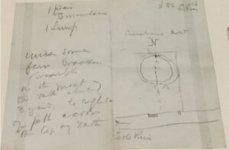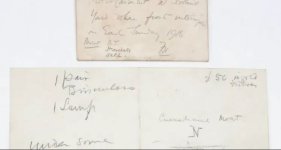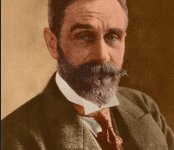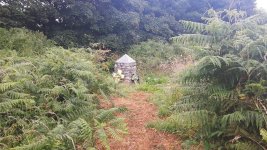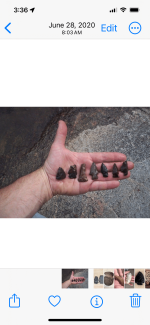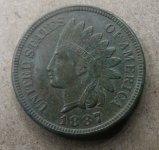Crow
Silver Member
- Jan 28, 2005
- 3,332
- 9,309
- Detector(s) used
- ONES THAT GO BEEP! :-)
- Primary Interest:
- Other
Most alleged treasure maps turn out to be fake. Perhaps 99%? many was product of scammers and such. But it is highly presumptuous to dismiss all alleged treasure maps as being fake? Yet many people do?
The following treasure map is a rare point in question?
Treasure maps rarely yield results — but this one drawn by Roger Casement 100 years ago appear to have yielded gold for the British authorities. But it brings to an end a century-old mystery about a document that had not been publicly seen since the destined-for-execution Sir Roger drew it on Easter Sunday 1916 after being shipped from Kerry to London. The former diplomat was detained after coming ashore from a German submarine at Banna Strand in Tralee Bay days earlier.
Apparently written while he was in custody, the pencil-drawn sketch depicts the fairy-fort where he was eventually captured, close to Currahane Moat near Ardfert. Above it, he wrote: “£50 in gold + silver.”He scribbled alongside the drawing that there were a pair of binoculars and a lamp “under some fern bracken and bramble in the moat of the rath about 3 yards to right of path across the top of rath”.
Casement had given the information to his captors so someone would be sent to find the money, which he needed badly to mount a defence. His defence was unsuccessful, as it happened, and in August 1916 he was executed for treason in connection with his links to the 1916 Easter uprising, following a trial in England.
According to Kerry Museum curator Helen O’Carroll who now has the map in the county Kerry museum. they bought the map for 7000 euros in 2016.
The map had never been seen since he drew it, despite efforts of his solicitor to find out about it after his execution. In February 1917, a police search party made another effort and a report was sent back to say that they had found nothing?
But an accompanying note written by one of his interrogators, Major Frank Hall, outlines how the cache was distributed, including money for the local Royal Irish Constabulary (RIC).
“His binoculars were given to Basil Thomas/Gold sleeve links to DI Cheesman/‘Flag of Irish republic’ to RIC mess Phoenix Park/Cash to Sgt. & Constable RIC/3 mauser pistols to me. I gave one to [Major Ivor] Price who used it at Connie Marciewitz [sic] at the Castle & missed her,” Hall’s note reads.
The map turned up in 2016 One of Hall's descendants has consigned items of "memorabilia surrounding the 1916 Easter Rising" relating to both Hall and Casement to Chorley's auctioneers in which the Kerry museum bought in 2016 and the mystery of what happened to casement treasure was solved. Today the old iron age fort mound still exists. and it is now called Casements fort. You can visit the site. there is a small memorial to Roger Casement inside the fort.
While treasure was small but important historically as it was connected to Irish independence. It does prove the point in Question some treasure maps are real. This was verifiable discovery of treasure from a treasure map.
Crow
5
The following treasure map is a rare point in question?
Treasure maps rarely yield results — but this one drawn by Roger Casement 100 years ago appear to have yielded gold for the British authorities. But it brings to an end a century-old mystery about a document that had not been publicly seen since the destined-for-execution Sir Roger drew it on Easter Sunday 1916 after being shipped from Kerry to London. The former diplomat was detained after coming ashore from a German submarine at Banna Strand in Tralee Bay days earlier.
Apparently written while he was in custody, the pencil-drawn sketch depicts the fairy-fort where he was eventually captured, close to Currahane Moat near Ardfert. Above it, he wrote: “£50 in gold + silver.”He scribbled alongside the drawing that there were a pair of binoculars and a lamp “under some fern bracken and bramble in the moat of the rath about 3 yards to right of path across the top of rath”.
Casement had given the information to his captors so someone would be sent to find the money, which he needed badly to mount a defence. His defence was unsuccessful, as it happened, and in August 1916 he was executed for treason in connection with his links to the 1916 Easter uprising, following a trial in England.
According to Kerry Museum curator Helen O’Carroll who now has the map in the county Kerry museum. they bought the map for 7000 euros in 2016.
The map had never been seen since he drew it, despite efforts of his solicitor to find out about it after his execution. In February 1917, a police search party made another effort and a report was sent back to say that they had found nothing?
But an accompanying note written by one of his interrogators, Major Frank Hall, outlines how the cache was distributed, including money for the local Royal Irish Constabulary (RIC).
“His binoculars were given to Basil Thomas/Gold sleeve links to DI Cheesman/‘Flag of Irish republic’ to RIC mess Phoenix Park/Cash to Sgt. & Constable RIC/3 mauser pistols to me. I gave one to [Major Ivor] Price who used it at Connie Marciewitz [sic] at the Castle & missed her,” Hall’s note reads.
The map turned up in 2016 One of Hall's descendants has consigned items of "memorabilia surrounding the 1916 Easter Rising" relating to both Hall and Casement to Chorley's auctioneers in which the Kerry museum bought in 2016 and the mystery of what happened to casement treasure was solved. Today the old iron age fort mound still exists. and it is now called Casements fort. You can visit the site. there is a small memorial to Roger Casement inside the fort.
While treasure was small but important historically as it was connected to Irish independence. It does prove the point in Question some treasure maps are real. This was verifiable discovery of treasure from a treasure map.
Crow
5


